Make Your Yard Work Easier With These Expert-Recommended Self-Propelled Lawnmowers
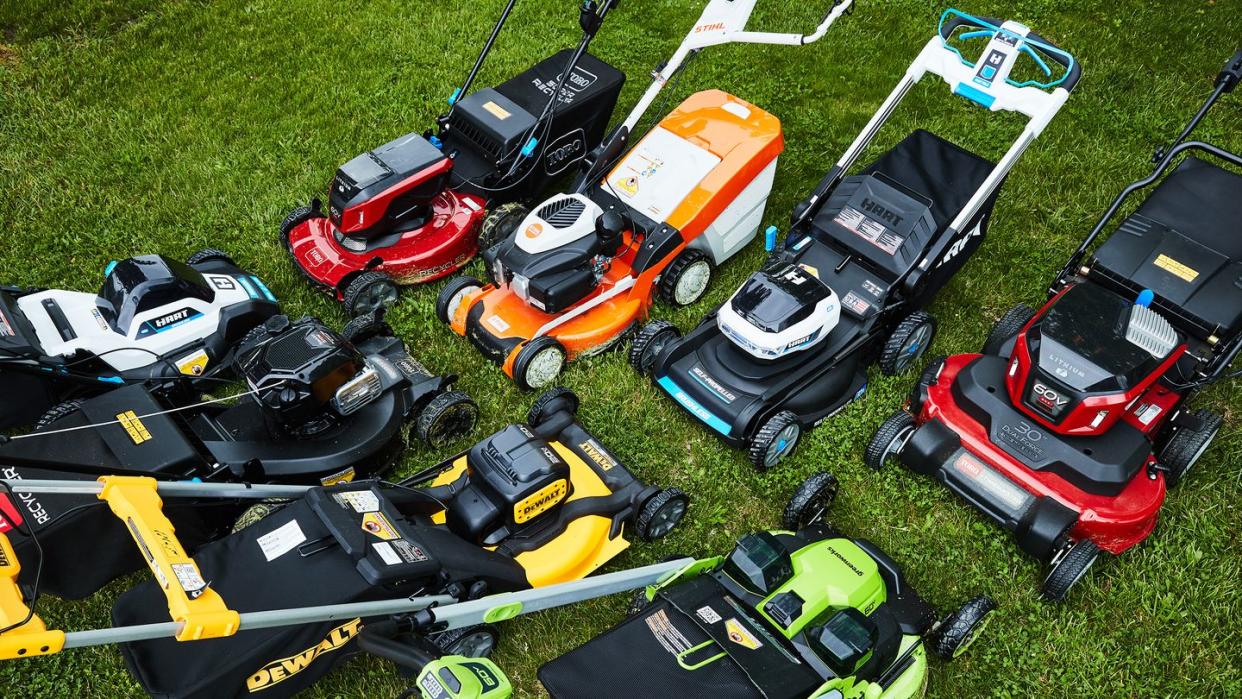
"Hearst Magazines and Yahoo may earn commission or revenue on some items through these links."
Warmer weather means lawn mowing season is upon us. While some homeowners may opt for a robot lawn mower, for many of us, actively mowing the lawn is a rite of passage, but that doesn't mean you have to tire yourself out in the process.
The primary difference between a standard push mower and a self-propelled mower is that the former moves when you push it, and the latter essentially moves itself with only your guidance. Once the engine or motor is running, all you have to do is squeeze a handle or push a lever and the mower will start moving forward with you as you walk.
Turning the mower around is your job, but once you have your heading, just keep the drive handle squeezed and escort the mower down the path, no pushing necessary.
Self-propelled lawn mowers take power off the engine or electric motor and route it via a belt to a pulley on the transmission and axle. When you move the drive control lever on the mower handle, you tension the belt, causing the pulley to turn, and this drives the transmission, moving the mower forward.
Move the drive control lever back and the tension is released, the pulley stops turning, and the mower stops moving forward. The belt-driven transmission is a time-tested design to power the mower and take the load off you in the process.
The market has flooded with new battery-electric options, both supplementing and supplanting the tried-and-true gas-powered mower. Battery mowers have made significant gains in the market, but gas-engine mowers are still a smart solution for many. You'll find plenty of self-propelled mowers in both varieties.
The Best Self-Propelled Lawn Mowers
Best Overall: Toro Super Recycler 21565
Best Cut Quality: Toro Recycler 60-volt Max 21469
Best U.S. Built: Ryobi 40-Volt Brushless Self-Propelled Mower
Best Wide Cut: Toro TimeMaster
Best Budget: Craftsman M220
[table-of-contents] stripped
What to Consider
A mower is like many consumer products in that the more features a manufacturer adds, the more expensive it becomes. But a longer or more eye-catching list of features isn’t necessarily better. Sometimes less is more. Here are the most important things to keep in mind.
Driven Wheels and Speed Control
Front-wheel drive mowers tend to be less expensive than rear-wheel drive units. They can be easier to turn because you don't have to disengage the drive wheels to do so. Simply push down on the handlebar to raise the front wheels off the ground, and turn. However, their traction isn't as strong on hills or when the bag is full, as there isn't as much weight over the driven wheels.
Rear-wheel drive mowers tend to cost more and aren't as easy to turn, as you need to disengage the drive—but this isn't too much of a hassle. Rear-wheel drive mowers shine on hills and inclines, and when the grass bag is full. In either scenario, weight is shifted rearward and over the drive wheels, which enables superior traction, thus making the self-propel more effective.
Activating the self-propel function may be slightly different depending on what brand of mower you buy. These mechanisms can include a squeeze handle, a drive bar that you press forward, or even a dial. There’s no single right answer here. Look at the design and think about how you like to work.
For example, if more than one person will be using the mower (and not all of them are right-handed), a drive control like Toro’s Personal Pace system might be the answer. Just push the drive handle on the bar to make it go faster, or let up on the bar to slow down.
Engine/Motor
Battery-electric mowers are now prolific in the push-mower industry. We have historically performed a measured area test, wherein we would run an electric mower until the battery dies. As the technology has progressed, that has taken longer, and longer, and longer, to the point where conducting such a test is unfeasible. All this is to say that battery-electric mowers are not second-class citizens in regard to regular cutting performance.
Still, they do have some drawbacks, such as the need to recharge once the battery does deplete, and if your grass is particularly wet and heavy that added strain will draw down the battery quicker.
This is where gas mowers shine. While they don’t get as much attention these days, gas mowers are still a great option for many homeowners, especially those who have thick grass or plan to use their mower for extensive fall cleanup. That being said, gas mowers require more maintenance than electric ones, and are louder and not as clean.
You can get a gas-powered mower with an electric start feature, which lets you start the mower with the push of a button (like an electric mower), rather than using the pull cord. However, this feature can cost a couple hundred dollars on some gas mowers, and in our opinion may not be worth it for most users, as a well maintained gas engine does not require a lot of effort to start the old fashioned way.
Deck Function and Material
A mower that can bag, mulch, and side discharge is known as a three-function mower, the most versatile kind. Two-function mowers bag and mulch or mulch and side discharge.
Most mowers are made with either steel or high-impact plastic decks. Steel decks are prone to rusting if not maintained, which is something to keep in mind.
Some higher-end mowers, such as the Toro Super Recycler featured in this roundup, feature a corrosion-resistant aluminum deck, which is less likely to corrode but still needs to be kept clean for optimal performance. Many electric mowers feature decks made of a plastic composite that is strong enough to withstand the rigors of mowing, but also won't rust.
Cutting Width and Height Adjustment
Typical walk-behind mowers are 21- or 22-inches wide and have a single blade. Wide-cut mowers built for residential use have either a single blade or, more typically, a pair of blades, and cutting widths of 25- to 30 inches. The wider cut lets you reduce the number of passes needed to complete your mowing job compared to a standard-sized mower. Of course, these wide mowers tend to cost more.
Mowers will typically have one, two, or four levers to control the deck height. Single-lever adjustment is the easiest to use, but it requires more linkages, which adds weight and complexity to the mower. If, for some reason, you find yourself varying deck height frequently, it’s a good option. Otherwise, two (one for each axle) or four (one for each wheel) levers work just fine.
How We Tested and Selected
We compiled this list based on Popular Mechanics mower testing and our knowledge of the lawn mower market at large. For our testing, we put mowers through the paces using our standard Popular Mechanics methodology: We cut various grass types in various conditions, including suboptimal thick and wet grasses, as well as dry and dusty surfaces, and we evaluated bagging and mulching performance in these various circumstances. We mow uphill, downhill, and across the faces of hills. The maximum slope we cut is about 30 degrees.
Our Full Self-Propelled Lawn Mower Reviews
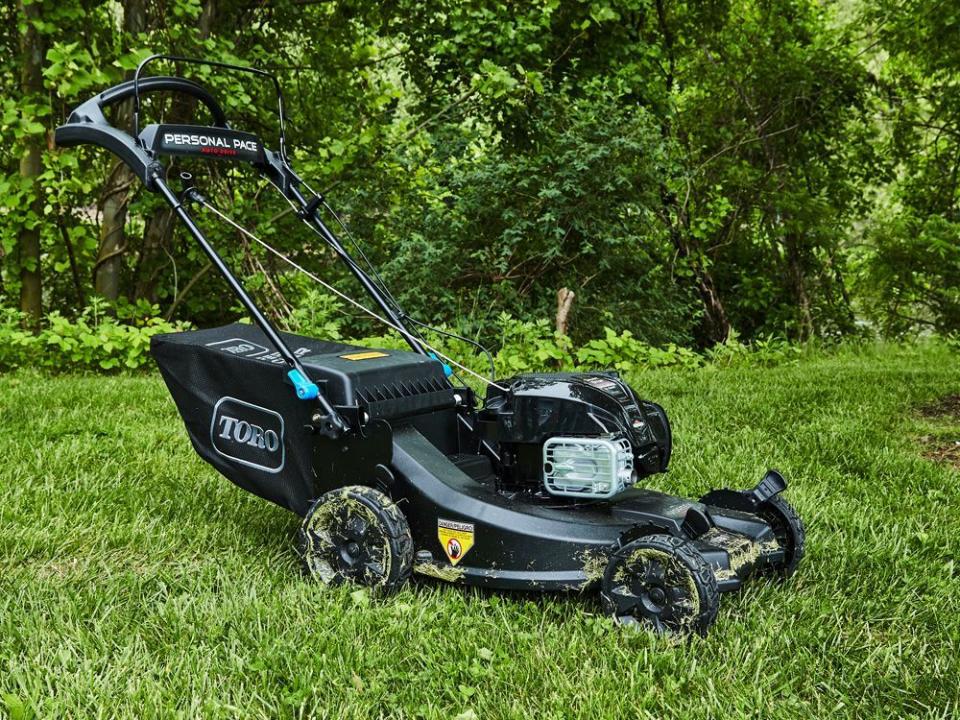
Super Recycler 21565
lowes.com
$799.00
Trevor RaabWe’ve become big fans of battery mowers because they’re so quiet and clean, but our heart will always flutter with gas engine mowers such as this Toro Super Recycler. One lazy pull on its recoil rope and the 163cc Briggs & Stratton engine springs to life. Wheel it over the lawn, especially through tall and wet grass, push forward on the Personal Pace drive handle, and it just chugs blissfully along, leaving a neatly mowed surface.
Even more impressive is the fact that it bags nearly every shred of grass that it cuts. We were also impressed with its mulching capability, given how soggy the conditions were when we ran the test. If the Super Recycler will mulch grass as wet as what we were cutting, then its mowing under normal conditions is sure to be particularly good, earning its nomenclature wholeheartedly.
We partially attribute that mulching ability to the two wedge-shaped baffles under its deck, and a blade-mounted gadget that Toro calls an accelerator. These features do appear to increase mulching performance under less-than-ideal conditions, though in this case they also accumulate wet grass clippings.
Be sure to check under the mower after you’re done and scrape or hose it down as needed. This is an expensive mower with a cast aluminum deck. Our hunch is that if you keep it clean and tuned up, you should have a long-lasting machine that delivers great mowing performance through three seasons, for many years to come.
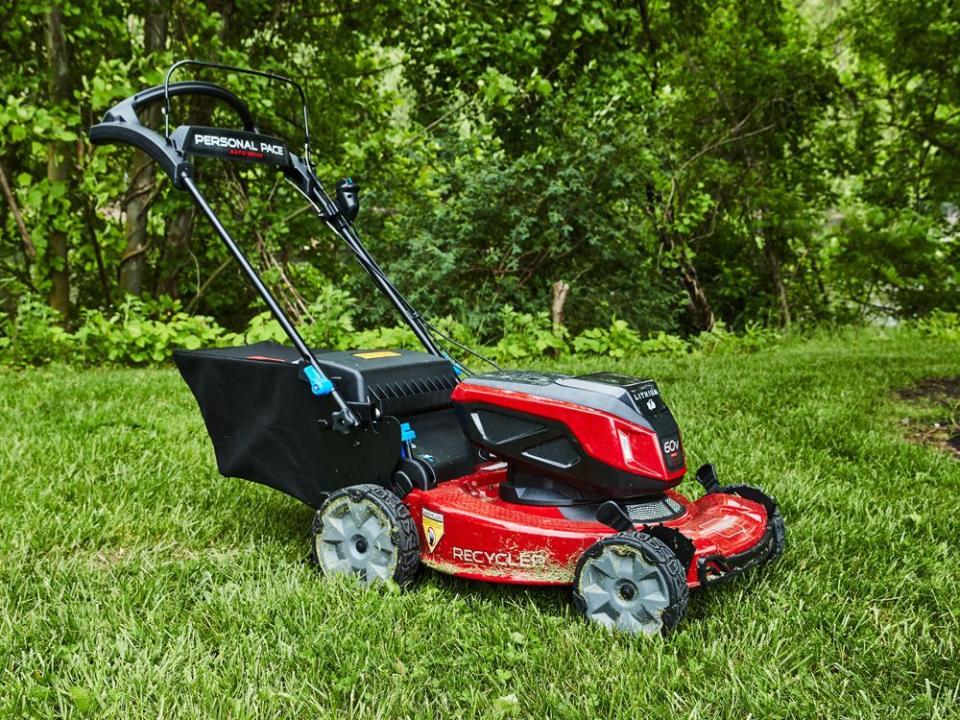
Recycler 60-volt Max 21469
lowes.com
$679.00
We never want to give any manufacturer a free pass in our testing, but Toro’s mowers perform so consistently well that we keep drawing the same conclusion with them: “Of course it does well. It’s a Toro.”
That’s the case with the 21469 60-volt Recycler, a reliable cordless electric mower that hits on the three criteria that we consider to be most important with this form of mower: cut quality, mulch quality, and bagging. The mower did well with all three of these. It’s a polite suburban machine for those reasons but also because it’s reasonably quiet. Like many high-quality mowers today, it's simple to operate: insert the battery and mow.
We exaggerate there, but only slightly. Like the Super Recycler listed above, this mower uses Toro’s Personal Pace system, a rear-wheel drive arrangement whereby the user presses forward on the handle push bar to make the mower propel itself forward. Release the handle push bar, and the mower stops propelling forward. The more fully you push the bar forward, the faster the mower goes up to its top speed, which is a comfortable walking pace–somewhere between a stroll and the fast trot that you need to keep up with many gas engine mowers.
The mower is a two-function machine: It mulches and it bags. To select between bagging and mulching, move a pivoting lever at the rear of the mower forward and back. The lever engages a mulch plate that blocks discharge to the bag; you’re simply lowering the plate to block airflow to the bag or lifting the plate to allow it.
While this Toro lacks the raw power of the gas-powered Super Recycler, it is definitely not too prissy to handle the rough stuff. Our test was under some very challenging and rather soggy mowing conditions. The Toro plugged its way along like the champ of a mower that it is.
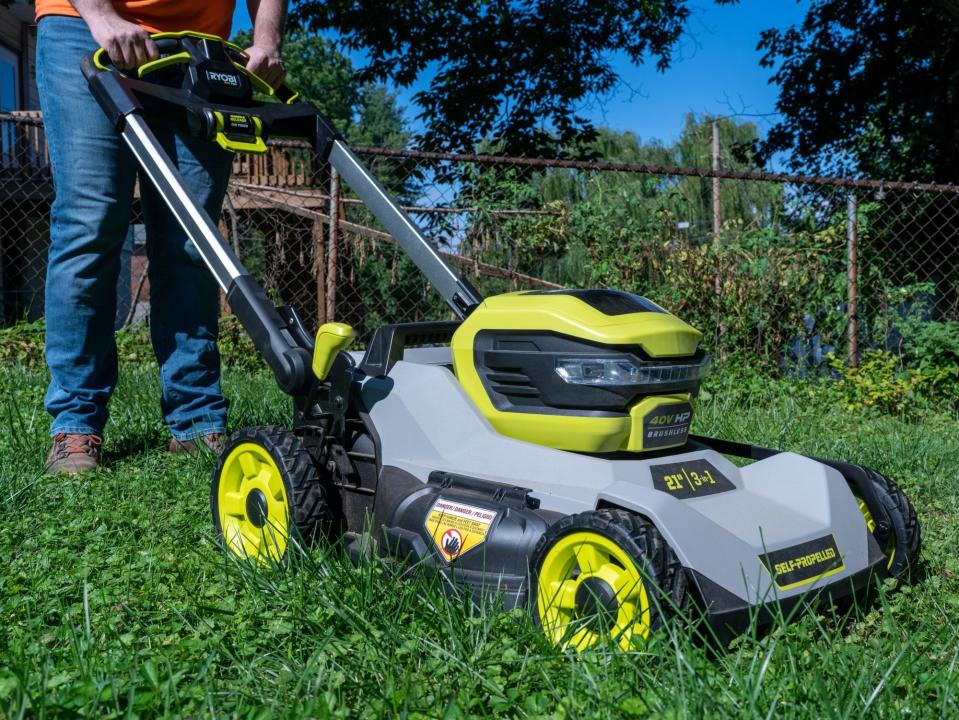
40-Volt Brushless Self-Propelled Mower
homedepot.com
$599.00
Thomas HenggeThis is one of Ryobi’s top-of-the-line mowers, and it’s American-made construction is something we wish we saw more of. It delivers a tremendous cut area with its two 6Ah batteries, providing a total of 12Ah of capacity. The mower's X-shaped blade leaves a pristine surface in its wake.
Ryobi estimates the design should provide 70 minutes of run time; we didn’t time our cut, but it strikes as plausible. Its rear-wheel-drive design and reasonably aggressive tire tread pattern provide good hill climbing and sidehill cutting performance, and its bagging on all surfaces (level, sidehill, and uphill) is also commendable.
Other ease-of-use features include an easily installed or removed bag that mounts and dismounts straight up and down through the handle; deck adjustment is quick and easy thanks to a single-level deck height adjustment. The straight edge deck is polypropylene; it will never rust and needs very little care other than basic cleaning.
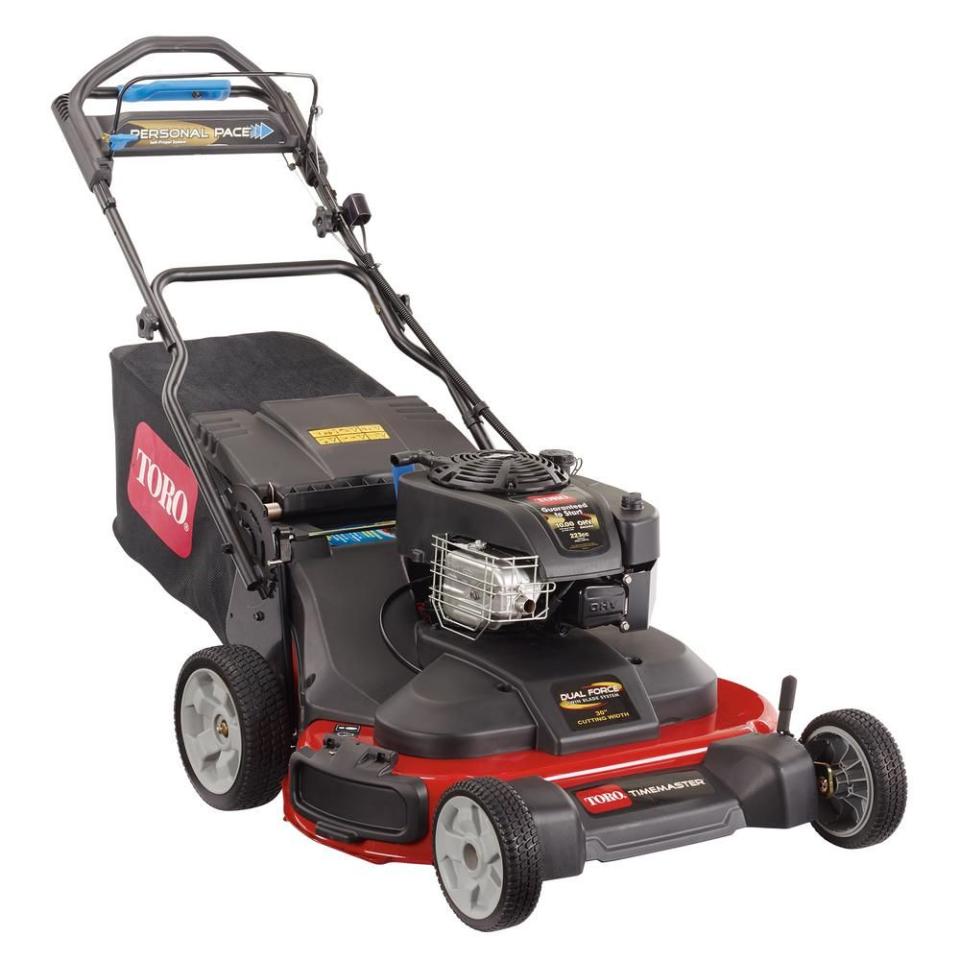
TimeMaster 30 in. Briggs & Stratton Personal Pace
lowes.com
$1499.99
The Toro Timemaster 30-in. mower has been around for a while now and has earned a reputation as a sturdy workhorse for homeowners who want to cut down on their mowing time. A few years ago, the Timemaster got a slightly more powerful Briggs and Stratton gas engine, giving it a boost to power through most demanding mowing jobs that may have challenged earlier iterations of the mower.
The Timemaster is rear-wheel drive and features Toro's Personal Pace drive system that's used on many of its self-propelled mowers. This allows the mower to move at your speed by simply pushing down or releasing the handle, which is spring-tensioned.
With a 30-in. deck, Toro claims the Timemaster will help you reduce your mowing time by about 40% compared to using a standard-sized mower. You can mulch, back, or side discharge with the Timemaster, and the handlebar can be locked in a fully vertical position to reduce space consumption in storage.
If you have half an acre to a full acre of lawn to mow and prefer the experience of a walk-behind mower versus a tractor or zero-turn, the Timemaster is worth a look.
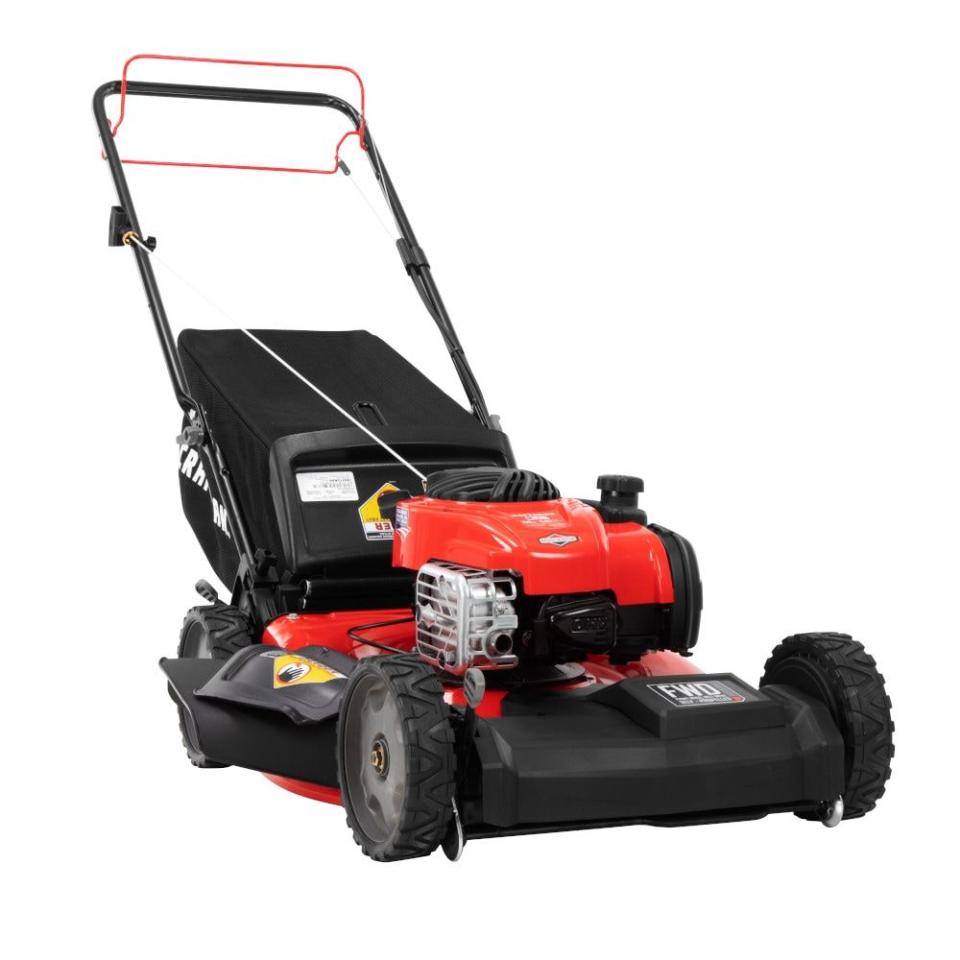
M220
lowes.com
$399.00
Craftsman mowers have performed well in our tests, so we can recommend this one because it’s so much like the many other of the brand’s models that we’ve used. If you’re looking for a good blend of maneuverability and power, you’ll get it with this mower. Its front drive helps move it along and makes it easy to turn.
It’s important to note that front-drive mowers do lose some traction when running uphill, particularly with a full grass bag. But if your slope is less than 20 degrees, and you’re not bagging uphill, you’ll be fine. The side discharge will also help you handle tall grass. Adjust the two deck levers to bring the mower up to full height and have at the rough stuff.
The fact that this mower bags, mulches, and side discharges is a plus, enabling you to handle a wide range of mowing conditions, from early spring and late into the fall. Three-function mowers like this are our preference for that versatility.
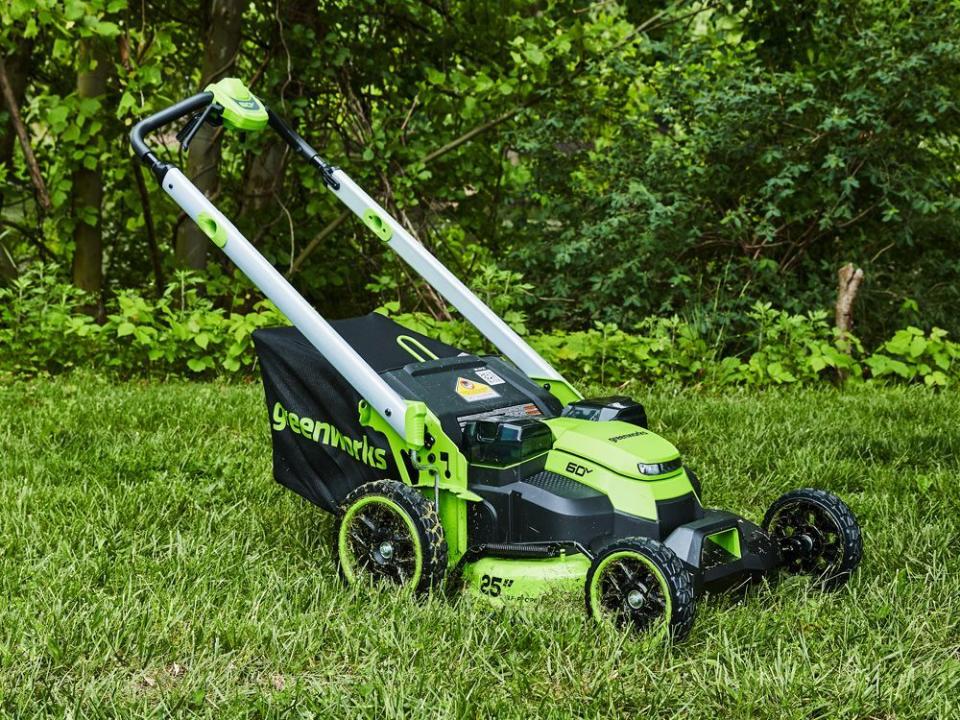
M060L428
walmart.com
$649.00
We love to cut grass; on the other hand, we’ve got nothing against getting the job done a little sooner. The hotter and stickier summer gets, the more we could see the value in running a mower like this Greenworks. With a 25-inch cutting width, it’s just a bit wider than the typical mower size of 21- to 22 inches. That may not sound like much difference, but that extra cutting width will help you finish faster than you would with a smaller mower.
The Greenworks’ geometry, weight distribution, and rear-wheel drive make it extremely maneuverable. With two drive-control levers, one on each side of the handle, we found that the mower cuts long, straight rows, but that we could also quickly switch to single-handed mowing when we needed to cut under and around low-hanging branches or shrubs.
The Greenworks offers good cut quality and bagging, but we did find that it is more height-sensitive than other mowers. At first, we weren’t getting quite the cut quality and bagging that we would expect, but then we lowered the deck just one notch and found both increased dramatically.
A single, well-positioned deck height control lever allows quick and easy adjustment. While this Greenworks is an expensive mower, it is well featured (not to mention it costs less than half what you'd pay for the electric Toro eTimemaster 30). You get two 4Ah batteries and charger, and the mower will run until both batteries are depleted (Greenworks claims the mower can run for up to 80 mins on a full charge of both batteries).
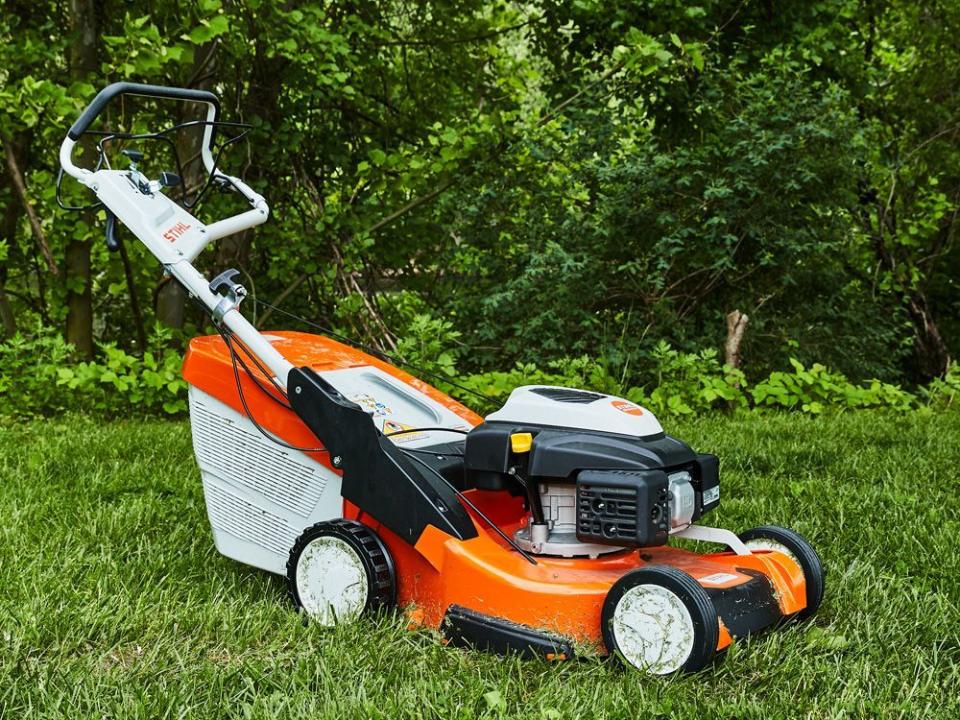
RM 655 YS
stihlusa.com
$1600.00
There’s no question that German brand Stihl takes building outdoor power equipment seriously—its chainsaws are some of the best in the business. It also has a new lawnmower that is impressive to behold. The brand's $1,600, 21-inch mower is equipped with an aluminum deck, riding on sealed-ball bearing wheels, and powered by a 173cc Kohler engine coupled to a hydrostatic drive.
A blade-brake clutch allows you to stop mowing, leave the engine running, and move lawn furniture or empty the bag. Separation of the engine, drive, and blade is also helpful in transport mode, and safer, too. You can power the lawnmower into the shed or garage, or drive the mower up a ramp into a pickup truck without the blade spinning.
The Stihl’s price tag is high, we admit, but so is its performance. Its cut quality is immaculate— it is the best bagging mower we’ve used recently, even out-doing our usual bag meisters, the recently-tested Toro mowers, long known for their bagging prowess.
And on that last point, we use the term “bagging” here somewhat loosely. The Stihl lacks the typical American-mower grass bag made out of porous synthetic cloth. Rather, it has a large plastic basket with a hinged lid. You have unfettered access to the basket owing to the machine’s unique handle–Stihl calls it a “mono-comfort handlebar” (or mono-komfortlenker for our German readers). Stihl’s full-access design is an improvement over the handlebar setups of most American mowers, even with recent improvements.
Other features on the Stihl to ease the operator’s work include its spring-assist deck height mechanism. It’s a small and discreet lever that enables you to use no more than fingertip pressure to raise and lower the deck. The only improvement over that would be an electrically-operated deck height adjustment mechanism, which is not offered on any walk-behind mower that we know of.
Q+A with Mowing Expert Roy Berendsohn
Are there special maintenance considerations with self-propelled mowers?
Yes. Both front- and rear-wheel drive mowers typically feature a drive belt, which can crack or wear out over time. Fortunately these belts are not difficult or particularly expensive to replace.
Secondly, you may have to replace the drive wheels occasionally. These wheels are driven with gears - there are typically teeth on the inside diameter of the drive wheel that line up with a gear on the axle. These teeth can wear out, especially if they are made of plastic. Higher-end mowers may feature drive wheels with a metal gear that meets the metal axle gear, improving the longevity of these components.
My lawnmower says I don’t ever have to change the oil, but just add oil when needed. Is this OK?
It’s not a good idea to never change the oil in your lawn mower. In a lawn mower, same as a car, oil degrades over time and is less effective at reducing heat and friction in metal components. Changing the oil in your lawn mower is easy to do and will significantly increase its service life.
For most homeowners, changing the oil at the beginning or end of each mowing season should be sufficient, though there is certainly no harm in doing it more often.
You Might Also Like

